
Issue #: 167
Published: September / October 2019
- Price per issue - digital : 6.20€Digital magazine
- Price per issue - print : 8.50€Print magazine
- Access to Multihulls World digital archives Digital archives
We are a couple with an 8-year-old child. Marie, 30, is employed as a physiotherapist and Michel, 56 was a cardiologist at the time of departure. It was the idea of this trip that brought us together: Marie walking alone with her rucksack, and me… well I’d been dreaming about sailing around the world since I was 8 years old… She finally hung up her walking boots in exchange for a 50-foot catamaran.
We are from Bordeaux. We left our respective professions behind, with the idea of coming back to them after the journey. Today, this seems less and less likely to happen…
In 2013, we set off around the Mediterranean for 5 months on our first boat, a Lagoon 380, Zazen. Timothee was only 2 and a half years old, and we weren’t constrained by the obligatory schooling. Our project at that time was to work for six months of the year and to sail for the rest of the time while gradually working our way around the world in stages. We knew a few crews who managed like this… However, as we were both working in the health service, this seemed a rather difficult option. Our heads would be at work when we were at sea and vice-versa. So, we concentrated on work with the intention of setting off for a longer period, a few years down the line.
In the fall of 2015, we bought Frédocéan, an Eclipse 472 that had been extended by 1.2m (4’). She had been built by an amateur (Didier Quidellur, see inset) and seemed to fit perfectly our particular round the world program. She was very well equipped, and we spent quite some time getting used to her… This was important as the boat hadn’t sailed for a long time, and there were lots of areas to refresh or repair. We rechristened her Caretta because of a large Marquesan style turtle that was drawn on the saloon table. In 2016 everything started to fall into place. But a voyage around the world takes a long time to organize, and it was only by the end of September 2017 that we finally set off, having sorted out all our professional and administrative issues and rented out our house. We also needed time to finalize our projects with Voiles Sans Frontières (Sails Without Borders) - installing water filters, distributing pairs of eye-glasses - and our collaboration with Ifremer (French Marine Science Research Institute).
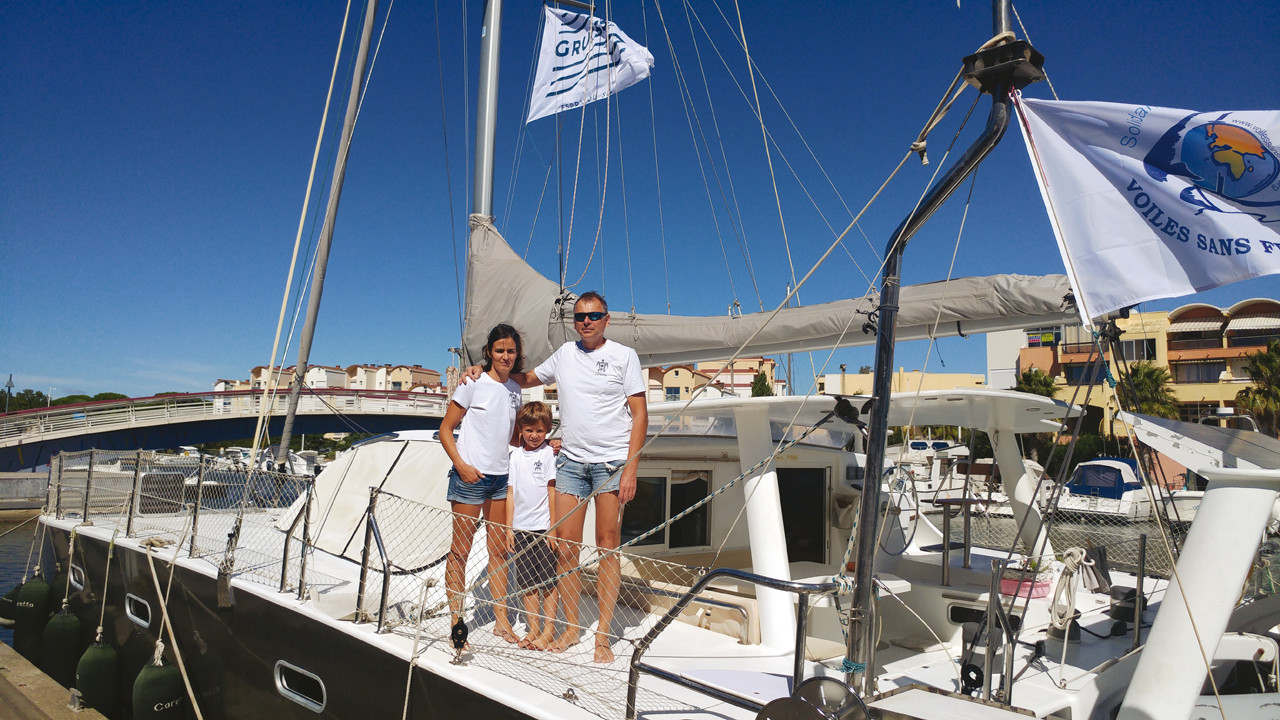
September 26, 2017 was the big day! The stocking up was done that morning. This wasn’t just some summer getaway cruise: we had been living on board for almost a month at that point and the days had been passing very quickly. There was so much to do: storing the dozens of books and personal effects, maximizing the cupboard space, testing all of the electronics, the OpenCPN cards, the engines, little repairs here and there, getting the watermaker up and running, adding an opening hatch to the coachroof, going to Toulouse to get the 100 water filters which had just been packed up, and then stow them away, getting the enormous Ifremer beacons on board, selling (or rather giving away) our last car, repairing the folding bikes, etc. Over the final few days, Marie’s parents had really helped us by managing all the logistics. At last we set off very discretely with just those closest to us present. Marie doesn’t like goodbyes!
However, as soon as we were off downwind under spinnaker, we realized that the rudders weren’t aligned properly. The two hydraulic rams were offset. We decided to make a technical stopover in Canet en Roussillon where there was a hydraulic technician. This problem annoyed us the whole way to Gibraltar as the rudders moved again, 30° in just a few hours. None of the many mechanics that we talked to could help us. The final answer came from a South African man, based in Gibraltar. He physically connected the two rudders with an aluminum bar, so now there was only one ram controlling both rudders. A rather radical solution, but extremely efficient!
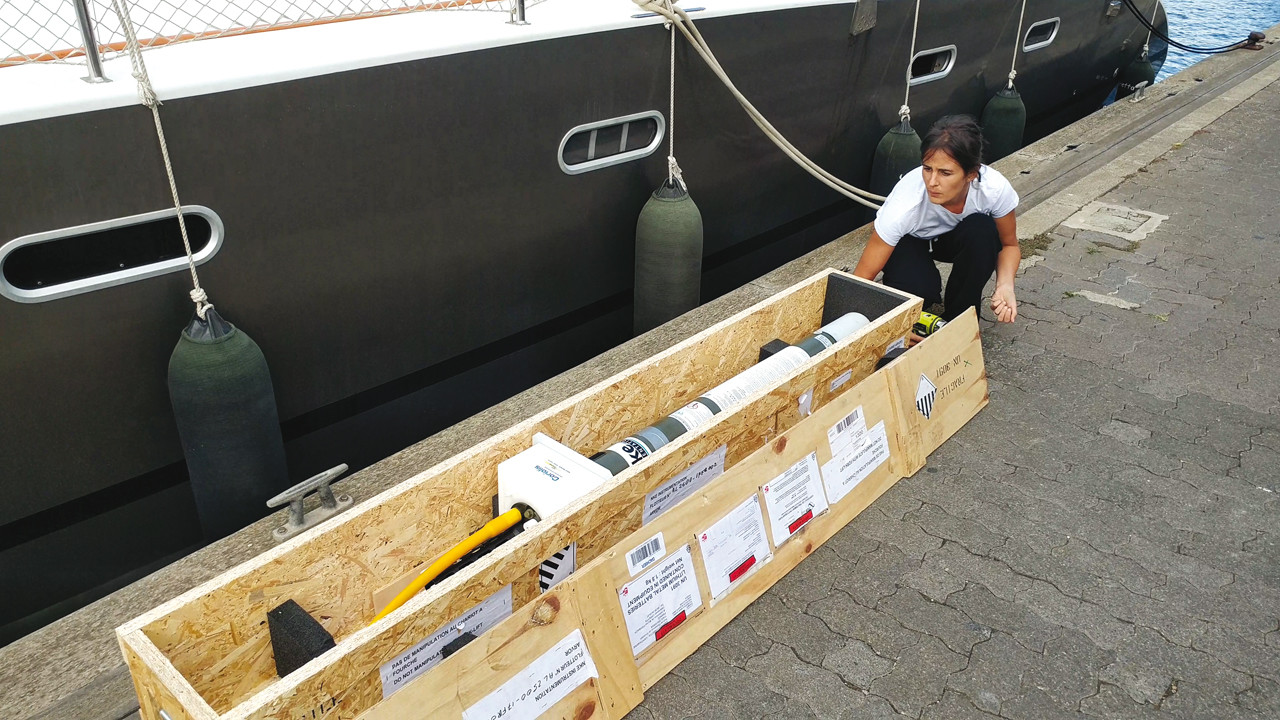
Apart from the problem with the helm, the journey towards Gibraltar was pleasant. We extended our summer in Majorca, where the water temperature was still 25°C (77°F) and in October the anchorages were almost deserted. Then Cartagena, which was a lovely stopover in the heart of a roman city followed by Almerimar, a pretty port which probably holds the record for being the cheapest in the western Mediterranean. From this port it is easy to get to Granada and the Alhambra. Our stopover at la Linea, next to Gibraltar, was quite long, as we needed to get hold of all the parts we needed for the new tillers.
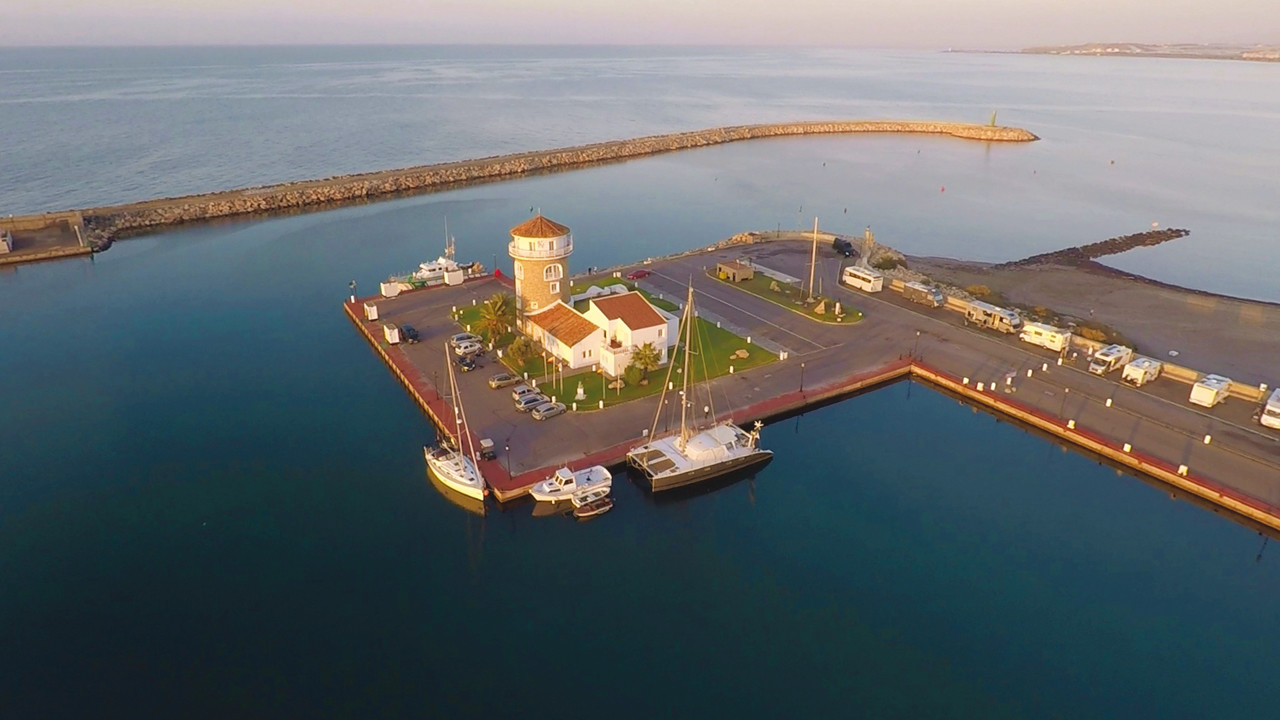
Rabat is a pleasant stopover with an ultra-modern marina which is secure and fairly cheap. However, the access into the Bouregreg river is not easy, and is in fact impossible when the Atlantic swell is more than two meters (6’), which is pretty often… A marina RIB came to get us and then piloted us through the entrance of the river, almost scraping along the bottom. While we were there, we took that opportunity to visit Fes. It’s a fantastic city which houses the world’s biggest medina. We didn’t have much wind as we headed for the Canaries apart from the Venturi effect between La Graciosa and the high cliffs in the north of Lanzarote. The wind blows down the hillside arriving in the Playa Francesa anchorage by La Graciosa at over 30 knots. We had to leave the little port of La Graciosa as it was not well sheltered at all, and head for the south of Lanzarote where we settled into the Rubicon marina: very beautiful but very expensive…
The anchorage at Las Palmas on Gran Canaria has the advantage of being right in the center of the largest town in the Canary Islands. You have to pay though now and it’s not cheap. Walking around the island’s more inland areas is fantastic, and the mountains are stunning.
We sailed along the northern coast of Gran Canaria and anchored at the entrance of a cute little port: Las Nieves, located at the foot of one of the highest cliffs in the world. The third night, our paradise turned into hell, with the arrival of a katabatic wind of exceptional violence. The gusts were so strong that the wind and the sea seemed to become one. They reached over 50 knots and we had to spend some of the night at the helm with our hands on the throttle, and a shoal just 50 meters (160’) behind our catamaran. Despite this, the flags on the boats in the port, only 100-150 meters (330-500’) away were barely flying at all. Our neighbor’s dinghy blew away and got caught on a reef. We managed to pick it up before we set off the next morning once things had calmed down.
A stopover in La Goméra means you can visit what is one of the last tertiary forests left on earth. It is very humid and cold, right in the middle of an overheated and arid environment. Here again, the mountains are impressive. We watched the start of the “Atlantic Challenge”, a group of madmen who were going to row across the Atlantic. This put our tricky conditions between the Canaries and Dakar somewhat into perspective!
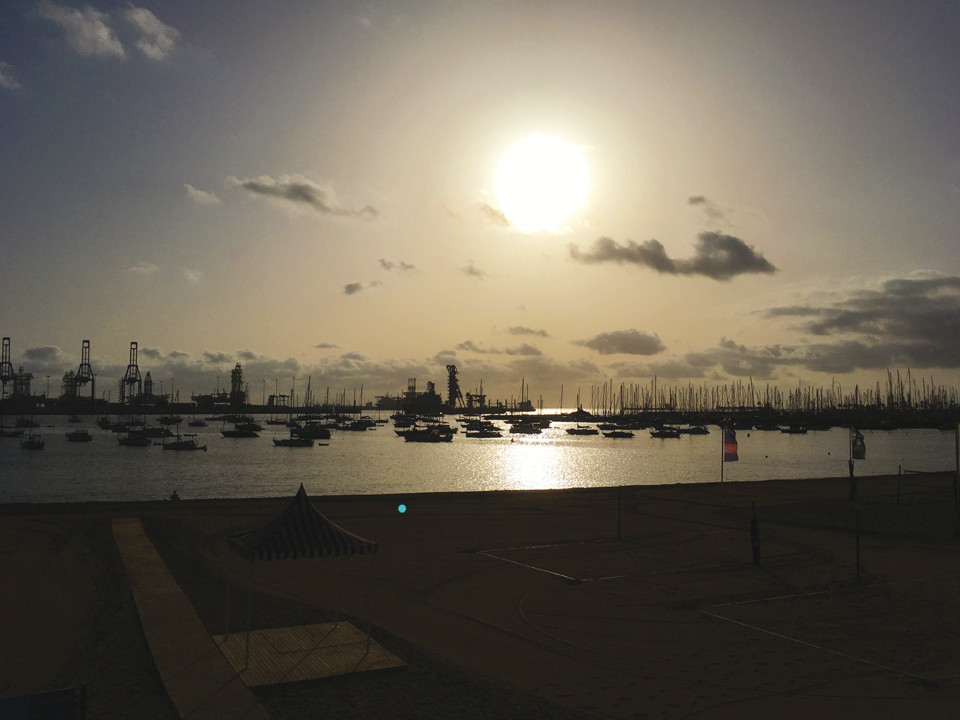
As part of our water filter mission, we spent two months in Sine Saloum! The time passed quickly in this enormous delta where you can sail just about everywhere. It’s an incredible birdlife’s sanctuary for any amateurs: hundreds of pelicans, “tocotocos”, greater blue-eared starlings, black and white African kingfishers, waders, ospreys etc… lots of incredible and lively colors!
We visited no less than 19 villages. However, our base camp was Moundé, where we had a wonderfully warm welcome. The teachers invited us to eat with them every day at lunchtime. We changed the batteries in the school’s solar panels which had stopped supplying 220v a long time ago. The two video-projectors could finally be used again!
We sailed 450km (240 nm) up the Gambia river. We passed hippopotamuses, crocodiles, baboons, chimpanzees and countless birds. The welcome in the villages was extraordinary. Africa will always stay a very special memory for us. More specifically its people and the wildlife, rather than its sea, which isn’t quite turquoise.
It was late in the season and all the boats had already left to cross the Atlantic. The trade winds were heading further and further north. Therefore, it was a close-hauled sail on the crossing to Cape Verde, with a very lively sea. As a result, I was seasick for the first time in 20 years. We were pleased with our speed though: 220 nautical miles in 24 hours of close-hauled sailing on a cat. How about that?
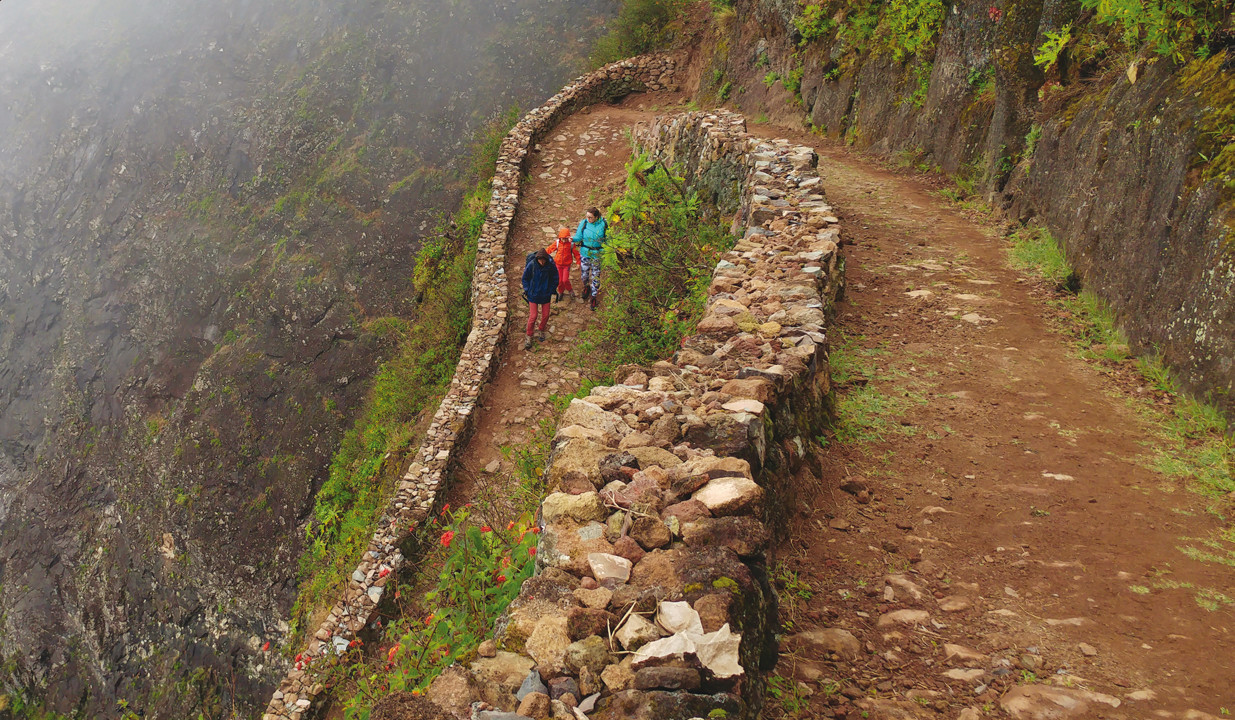
Getting to Cape Verde is a tough one! A solid trade wind makes any sailing between the islands pretty interesting to say the least. The anchorages are not particularly sheltered, and so safety is mostly hit-and-miss. The loveliest island doesn’t have any usable anchorages. If you want to go walking on San Antao, you need to leave the boat in a particularly pricey marina in Mindelo. The mountains and the hiking on San Antao are magnificent. Definitely not to be missed, are the vertiginous Paul valley and the track along the coast between Punta do Sol and Cruzinha. It’s 6 hours of pretty intense walking, but some of the views are breathtaking!
We set off late for our transatlantic crossing. There were only two or three boats left in Mindelo Bay at the beginning of May, and the winds could easily reach 35 knots in the anchorage. There was some pretty tough sailing. The first gybe cost one of the mainsail traveler cars. Luckily, we had a spare. The rest of our transat to Salvador de Bahia would be quieter apart from a few squalls in the doldrums, which we had to go through, unlike those boats heading for the West Indies. We arrived in Salvador after a 13-day crossing. We could have done it quicker, but we deliberately kept the boat under-canvassed. After two weeks of solitude, seeing the skyscrapers of this gigantic metropolis with more inhabitants than Paris gave us vertigo…
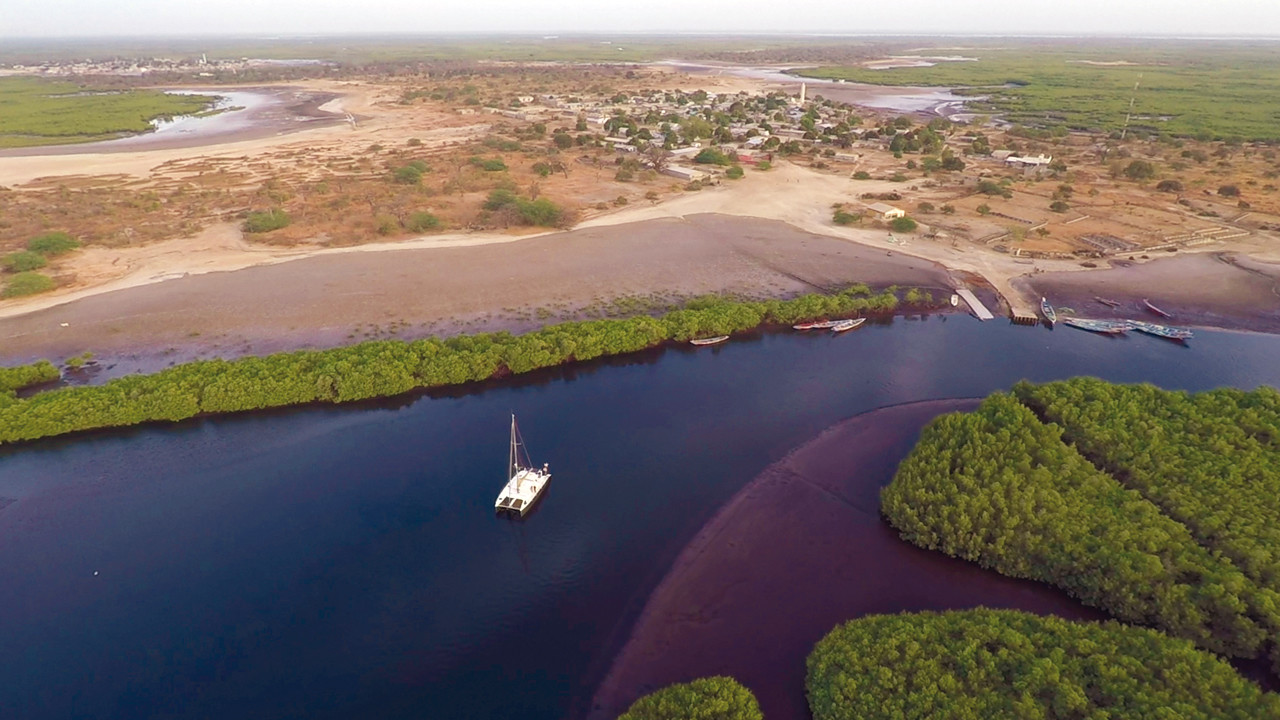
Brazil isn’t just a country, it’s practically a continent! Everywhere you go you get a warm welcome, and the famed Brazilian “joie de vivre” is a reality. However, swathes of the country have to live with high rates of violent crime, and our idea of sailing up the Paraguaca river in the large bay of Salvador had to be put on hold. Away from the large towns and cities, things are calmer, although we did avoid isolated anchorages in the bay of Salvador.
We went further south up the Do Inferno river from Moro Sao Paulo as far as the village of Cairu which is Brazil’s oldest colonial settlement. The Atlantic beaches are beautiful and practically deserted. We had to head to Salvador earlier than expected, as we had lost a propeller! We found a lovely anchorage in Garapua bay.
As Brazil only gives out three-month non-renewable visas, we left the boat in Itaparica marina, an island in the bay of Salvador, and set off backpacking to Peru for three weeks. That gave us three weeks extra visa time…
Then it was two weeks on the hard at Aratu to the north of Salvador for Caretta’s antifouling, and where Philippe, a former catamaran builder would sort out quite a few problems on our cat. We did a copper-based antifouling, but three months later we are not particularly convinced by it.
The trip up to Guyana was long. South America is big! We stopped for a few days in Jacaré’s small marina, which was run by two Frenchmen. There was a great atmosphere, and Nicolas’s meals were tasty and well-priced.
We stopped a little further north in the Lençóis Islands archipelago. We had initially planned to just stay for a few days but ended up spending three weeks there. Drinking water is a real problem here. We fitted water filters in five villages, mainly in public buildings such as schools and clinics…
The landscape of dunes as far as the eye can see is superb. Every day at 5pm on the dot, the scarlet ibis head for the mangrove where they will spend the night.
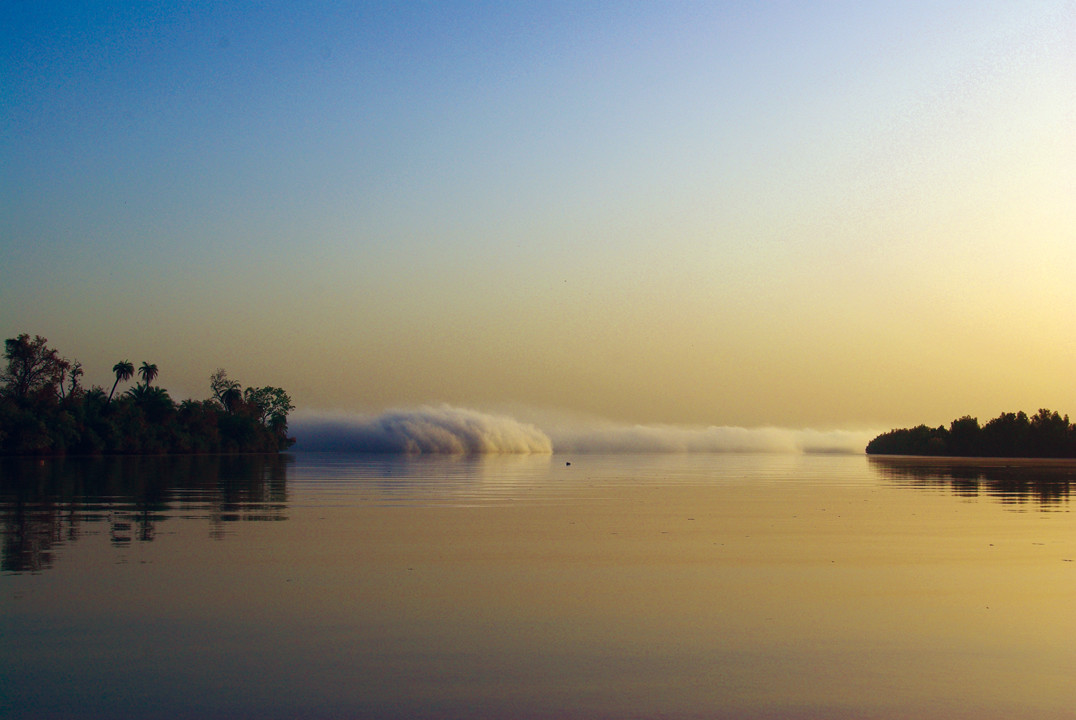
The welcome at Degrad des Cannes near Cayenne was fine, despite the underwhelming environment. The marina is miles from anywhere, but you can rent a car in Cayenne for €15 per day. Hitch-hiking also works very well! You will need a car to get around the country, and to visit the forest at least once though. You can bivouac in the “carbets” which are small shelters featuring a precarious roof to protect you from the rain and hooks for your hammocks (mosquito nets are mandatory!). We were lucky enough to be able to explore the Kaw swamp in a motorized pirogue that was landed to us! Many thanks to Eric and Sylvie!
We then sailed up the Mahury river, where the Dégrad de Cannes marina is situated, all the way to Stoupan. There is a bridge there, which prevents sailboats going any further. It’s a lovely anchorage in the middle of the forest, and it is where the Gabriel Crique begins. In this part of the world, a crique is a small river. Following it up on our canoe, we witnessed a practically untouched natural environment.
We then made our way to Kourou, and moored by the pontoon which was managed by the CSG (Guyanese Space Agency), because that evening, we were about to watch a rocket launch. The engines lit up the whole town! We were 15km (9 miles) away but it was still an impressive sight.
Before heading up to Tobago, we made a brief stop in the Salvation Islands. They were beautifully looked after, just like a garden, and there’s also the impressive visit to the prison (Devil’s Island).
Unfortunately, we didn’t have time to sail up the Maroni river as we were due to be in Guadeloupe on January 15 for the arrival of the in-laws!
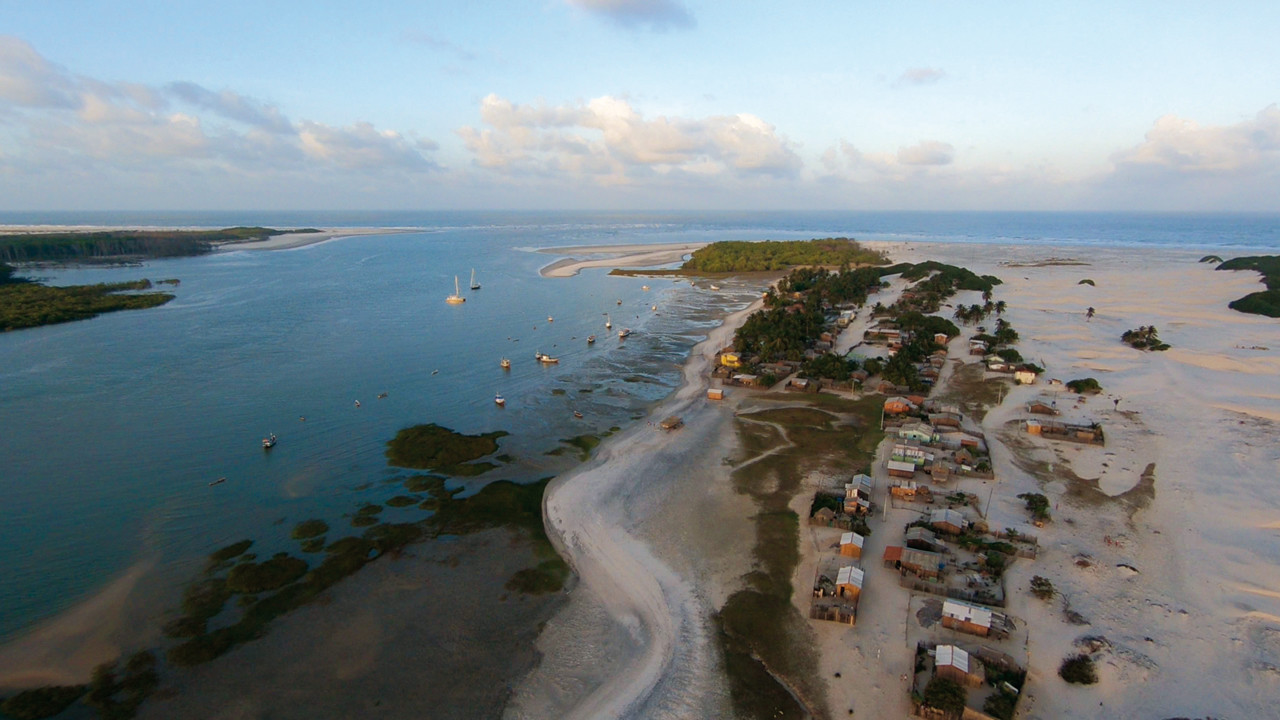
We made it to Tobago in quick time, pushed along by the powerful northwesterly Guyana current.
Charlotteville, to the north west of Tobago, is a well-protected and fairly quiet anchorage. There’s everything that you could need: shops, free Wi-Fi, fuel and a giant bookstore, worthy of a big western city. Amazing for a town with only 300 inhabitants. Trinidad & Tobago is a wealthy country… well, it has oil!
The wildlife on Tobago is magnificent. The world’s first natural park was created here. The snorkeling is also superb. The sea life is very rich because it benefits from Amazonian alluvial deposits washed across by the Guyana current. Despite this, the seawater is clear. We got a real shock when we arrived in Grenada though. There were hundreds of boats in the small Prickly Bay to the south of the island. We stayed just one night. We hadn’t seen so many boats in a year! The anchorage by the capital St George was much nicer, with a beach and turquoise waters. We made the most of being there and visited the island and its waterfalls in a taxi. (Avoid the excursions which are overpriced).
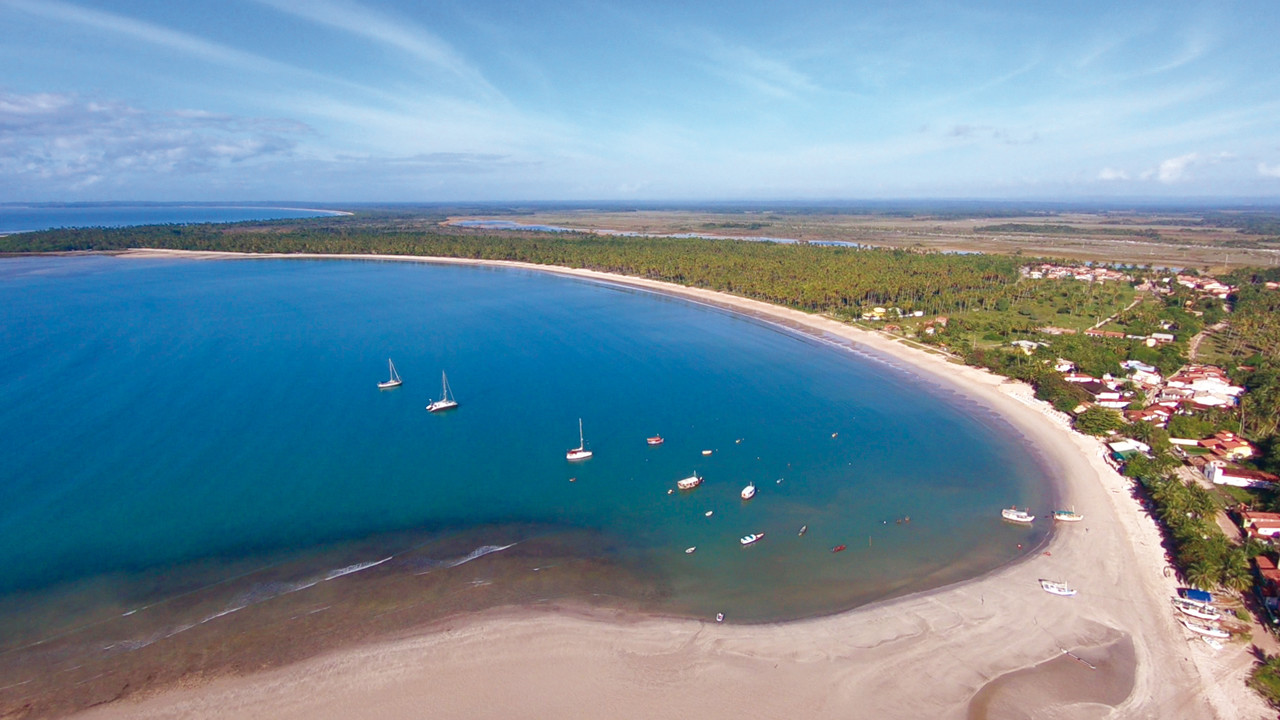
We did it. The West Indies! It was a big change from Africa, with turquoise waters, turtles and amazing snorkeling. The Tobago Cays are full of boats, but still beautiful, with their blues and greens, rays and curious turtles. We spent two weeks together with our family in Guadeloupe before heading down to Martinique and then back again to the Grenadines. We were loving it!
It was on our way back to Martinique, although well sheltered by the island’s southern coast and on a flat calm sea, that a wave came out of nowhere and hit us as we were going past the Diamant rock (see inset).
So, we ended up stuck in Martinique for three months whilst waiting for work to be done on the boat… We saw the silver lining there, and decided to visit the island, especially the north side. We also went back to some places that I remembered from the old days of my residency here… 30 years ago.
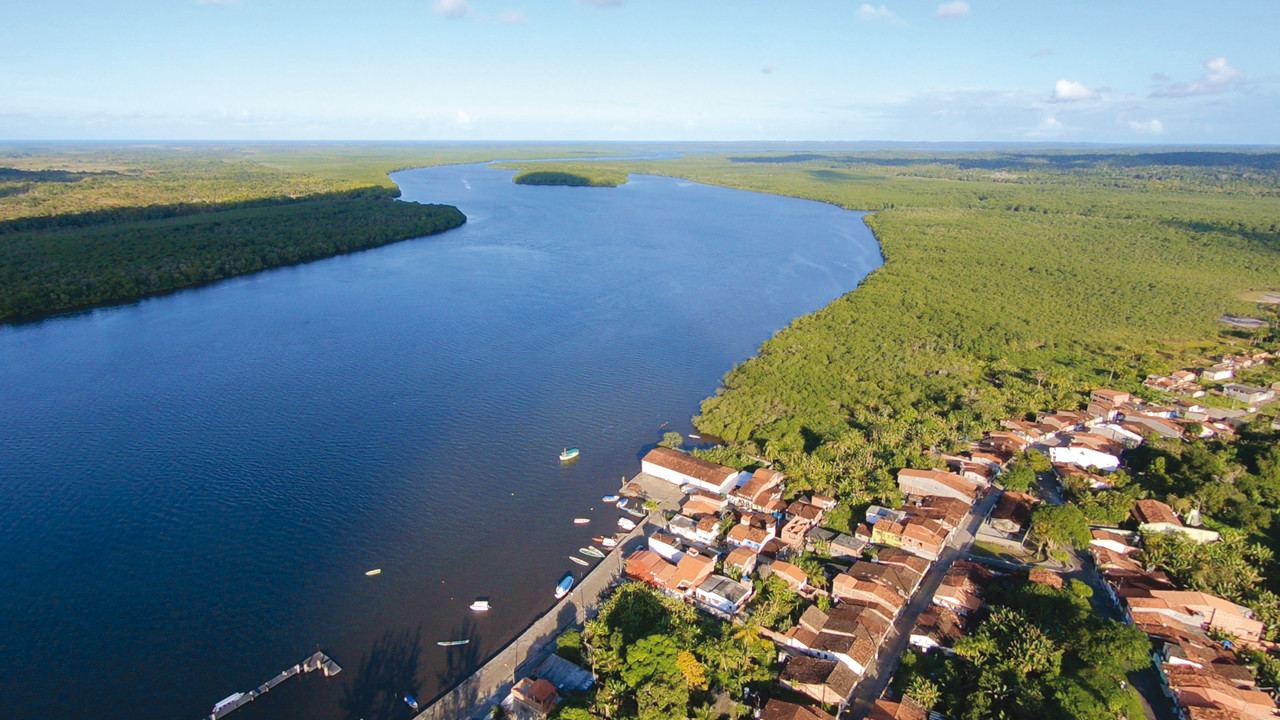
Tomorrow is another day… We have got some plans: St Martin, the BVIs (our insurance won’t allow us in US territorial waters), Dominican Republic, Cuba and then sail down the coast of Nicaragua to Panama.
We’d like to see the San Blas Islands and the Kuna Indians, especially because some villages appear to have problems with drinking water!
Then it will be the famous Canal, the Pacific coast of Costa Rica and then the big crossing to the Galapagos and the Gambiers followed by the Marquesas where we will wait for the end of the cyclonic season in French Polynesia.
Beyond this point, it all seems so far: Tuamotus, Tahiti, Bora Bora, Samoa, Fiji, then to New Zealand to shelter from the cyclonic season. We then want to visit New Zealand by land. Then, most likely New Caledonia, Vanuatu, Papua New Guinea, Darwin, Indonesia, Thailand, Sri Lanka, Mauritius, La Réunion, Madagascar, Mozambique, South Africa, Saint Helena, Ascension, Cape Verde and then back home…
Unless we find somewhere on the way, that we want to call home…
What readers think
Post a comment
No comments to show.